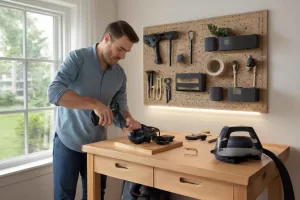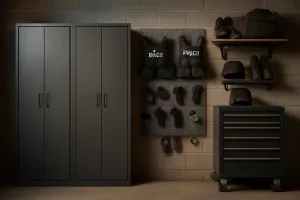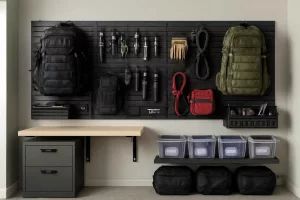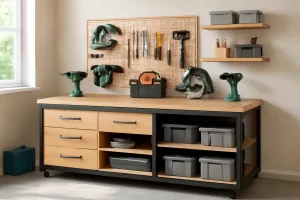Transforming a stationary workbench into a movable workstation can revolutionize your workshop’s functionality and efficiency. With the right workbench caster kits, you gain flexibility to rearrange your space, maximize workflow, and adapt your setup for different projects. Whether you’re tackling a weekend DIY build or a complex woodworking project, mobile workbench casters can help you position tools exactly where you need them. For a wide range of options, check out these top-rated caster kits on Amazon: Workbench Caster Kits.
In this comprehensive guide, we’ll cover everything from types of caster wheels and load capacities to installation steps and maintenance tips. You’ll learn how to choose the best caster kit based on your workshop flooring, workbench weight, and desired mobility features. We’ll also explore budget-friendly vs premium solutions, and provide detailed reviews of the top 7 workbench caster kits on the market. Ready to roll? Let’s dive in!
Why Choose Workbench Caster Kits?
Modern workshops demand versatility. A fixed workbench may suit heavy-duty stationary tasks, but many projects require repositioning tools or work surfaces to optimize lighting, dust collection, or team collaboration. Investing in a quality set of mobile workbench casters allows you to effortlessly relocate your bench, adapt your workspace layout, and even clear floor space when idle. These benefits make caster kits an essential upgrade for hobbyists and professionals alike.
Installing caster wheels on your bench doesn’t mean sacrificing stability. High-quality caster kits offer locking mechanisms and robust mounting plates to ensure your bench stays firmly in place during precision tasks. Once locked, you’ll scarcely notice any wobble or unwanted movement, giving you confidence to make accurate cuts, drills, and assemblies. Plus, you can pair your mobile bench with lockable rolling tool chests to create a fully mobile, organized work station that moves with your needs.
Space optimization is another compelling reason to choose caster kits. In small garages or workshops, every square foot counts. A mobile workbench can be rolled against a wall or tucked into a corner when not in use, freeing up central floor space for larger projects or equipment. If you use foldable furniture, like those foldable portable workbenches, integrating caster wheels lets you switch between compact storage and easy deployment without hassle.
Finally, caster-equipped benches enhance cleaning and maintenance. Easily move your bench to vacuum or sweep debris, then roll it back into place once your workspace is pristine. This advantage is particularly beneficial when using sawdust-heavy power tools or when applying finishes. With minimal effort, you can keep your workshop clean and safe, prolonging the life of both your bench and your equipment.
Types of Workbench Caster Kits
Before purchasing a caster kit, it’s crucial to understand the various types available. Not all caster wheels are created equal; differences in wheel material, mounting style, swivel design, and load capacity will influence performance and durability. By matching the right characteristics to your bench and workshop conditions, you’ll enjoy smoother mobility and fewer replacements over time.
Swivel vs Rigid Casters
Casters come in two primary configurations: swivel and rigid. Swivel casters rotate 360°, allowing you to steer your bench in any direction, while rigid casters move only forward and backward. A typical setup pairs two swivel casters at the front and two rigid casters at the back, combining maneuverability with straight-line stability. If you frequently reposition your bench around tight corners, prioritize swivel casters. For a straightforward track, rigid casters can support heavier loads and minimize lateral sway.
Adjustable Height Casters
Adjustable casters feature a built-in leveling mechanism, letting you fine-tune bench height or compensate for uneven floors. This feature is especially valuable when using large power tools that require precise alignment, like table saws or router tables. By adjusting each caster individually, you can ensure a perfectly level work surface even on slightly sloped concrete or worn wooden floors.
Brake and Lock Mechanisms
Safety and stability are paramount when working with heavy equipment. Most caster kits include locking brakes that prevent unintended movement. These brakes engage one or both wheels and often lock the swivel head as well, ensuring the bench stays fixed during cutting, sanding, or assembly. Look for high-quality lever or toe clamps that are easy to engage and hold firmly under load.
Mounting Plate vs Stem Casters
Casters attach to your bench via mounting plates or stems. Plate-mounted casters use a flat metal plate with pre-drilled holes for lag bolts or machine screws, offering maximum stability and load distribution. Stem casters feature a post that fits into a socket or bracket on the bench, providing a quick, tool-less installation in some systems. While plate mounts are more secure for heavy benches, stem casters can speed up installation and removal if you swap between mobile and stationary setups often.
How to Choose the Right Caster Kit
Selecting the best caster kit involves more than picking a stylish wheel. You need to evaluate load capacity, wheel material, floor compatibility, mounting options, and your workbench’s dimensions. A misjudged choice can lead to premature wear, bench instability, or damage to workshop floors.
Weight Capacity
Always calculate the total weight your bench will bear, including tools, hardware, and workpieces. Add a safety margin of at least 25% to account for dynamic loads when you move the bench. If your bench weighs 200 lbs and holds another 300 lbs of tools, you should aim for at least 625 lbs total capacity across all four casters (e.g., 160 lbs per caster). Opting for heavy-duty casters rated above your calculated load ensures smoother movement and longer life.
Wheel Material and Floor Protection
Caster wheels are commonly made from rubber, polyurethane, nylon, or steel. Rubber and polyurethane wheels offer quiet operation and floor protection, ideal for finished concrete or epoxy-coated floors. Nylon wheels resist wear and chemical exposure but can leave marks on softer surfaces. Steel wheels are typically reserved for industrial settings and may damage residential workshop floors. Match wheel material to your floor type and noise tolerance for best results.
Mounting Options and Compatibility
Check your bench’s frame design before buying. Plate-mounted casters need a flat, reinforced surface for installation, while stem casters require a compatible socket or bracket. Some workbenches come with pre-installed caster mounting points; others will need custom brackets. Measure your bench’s frame width and thickness to confirm that bolt holes align with the caster plate or stem diameter.
Adjustable Workbench Caster Wheels
If you work on uneven floors or need precise leveling, consider adjustable height caster wheels. These feature threaded stems or built-in screw jacks that let you raise or lower each corner of your bench by several inches. Adjustable casters help maintain a level work surface and reduce strain on your back and joints. They also ensure integrated tools like bench grinders and miter saws remain parallel to the floor.
Budget vs Premium Caster Kits Comparison
Caster kits range from budget-friendly basic wheels to premium casters with advanced features. Understanding the trade-offs between cost and performance will help you decide where to invest and where to save.
Budget caster kits typically offer basic swivel and rigid wheels made from plastic or economical rubber. They’re suitable for light-duty benches and occasional repositioning. You’ll save upfront by choosing budget casters, but they may wear faster, produce more noise, and offer limited braking performance. For casual hobbyists with lighter loads, these kits can be a practical choice.
Premium caster kits come with high-quality polyurethane wheels, robust mounting plates, and integrated leveling jacks. Brands like Eastwood or CasterDepot often include sealed bearings for smooth movement and corrosion-resistant finishes for long life. Premium casters handle heavier loads with ease and offer precise braking and height adjustment. Though pricier, they can reduce floor damage and maintenance costs over time.
For a balanced investment, consider mid-tier kits that use polyurethane wheels and steel plates but omit independent leveling jacks. These kits deliver quiet, smooth operation and solid braking. If you pair them with modular workbench drawer inserts underneath, you’ll maximize storage and accessibility without overspending on features you may not need.
Top 7 Workbench Caster Kits for Easy Mobility
- Black Polyurethane Swivel & Rigid Caster Set
Rated for 800 lbs total, this four-pack features two 4″ swivel wheels with brakes and two 4″ rigid wheels. Polyurethane treads protect floors and roll quietly under heavy loads. Easy bolt-on installation makes it a quick upgrade for most benches. View on Amazon - Adjustable Steel Plate Workbench Caster Kit
This kit includes four 3″ heavy-duty casters with integrated screw jacks for 1–2″ height adjustment. Ideal for uneven concrete floors, the steel frame supports up to 1,000 lbs and locks both swivel and wheel rotation for ultimate stability. View on Amazon - Budget Plastic Stem Casters
A cost-effective four-pack of 4″ plastic casters with swivel design. Stem-mounted for simple drop-in installation into compatible brackets. Supports up to 600 lbs total, best for light-duty benches or portable tool carts. View on Amazon - Locking Polyurethane Swivel Casters
Two swivel casters with lever-operated brakes, built-in bearings, and polyurethane wheels rated at 200 lbs each. Complements rigid casters for a stable setup when used as a pair. View on Amazon - Medium-Duty Nylon Rigid Caster Pack
Pack of two 4″ nylon rigid casters rated for 500 lbs combined, perfect for the rear of your bench. Wear-resistant and chemical-proof, though best on smooth flooring. View on Amazon - Heavy-Duty Industrial Plate Casters
Premium set of four 5″ steel casters with polyurethane covers, load-rated for 2,000 lbs total. Ideal for professional workshops with heavy machinery. Includes high-tensile mounting hardware. View on Amazon - All-Terrain Rubber Workbench Casters
Designed for concrete, wood, or even gravel workshop floors. Four 4″ solid rubber swivel casters with dual-lock brakes and sealed bearings. Supports 900 lbs and rolls smoothly over minor debris. View on Amazon
Installation Guide for Workbench Caster Wheels
Installing caster wheels is a straightforward process if you have the right tools and a clear plan. Follow these steps to retrofit your workbench with mobility without compromising stability or alignment.
Tools You’ll Need
- Power drill with drill bits matching mounting plate holes
- Socket wrench or adjustable wrench
- Measuring tape and pencil
- Level
- Clamps (optional for holding bench in place)
Step-by-Step Installation
- Flip the bench onto its top surface on protective padding to avoid scratching the finish.
- Position each caster at the corners, ensuring equal inset from edges. Mark bolt hole locations with a pencil.
- Pre-drill pilot holes for bolts or screws to prevent wood splitting. Use a bit slightly smaller than the fastener diameter.
- Align the caster mounting plate with pilot holes. Insert bolts or lag screws through the plate and into the frame. Tighten securely with a socket wrench.
- Once all four casters are attached, flip the bench upright. Check for levelness and adjust height jacks if using adjustable casters.
- Test swivel and braking functions. Lock the brakes and confirm the bench stays in place. Unlock and roll the bench to ensure smooth movement.
If you prefer a custom rolling station, pair your bench with a DIY rolling tool cart underneath. This combination turns under-bench storage into a portable tool chest that moves effortlessly with your work surface.
Maintenance Tips for Workbench Caster Wheels
Regular maintenance ensures your caster wheels continue to roll smoothly and hold weight without failure. A few simple checks and cleaning routines will extend the life of your kit and protect your workshop floor.
Cleaning and Lubrication
Every few months or after heavy use, inspect wheels for debris like sawdust or metal shavings. Clean the wheel treads with a damp cloth and mild soap. Dry thoroughly before use. Apply a light lubricant such as silicone spray to swivel bearings and axle shafts to reduce friction and prevent rust. Wipe away excess lubricant to avoid attracting dust.
Inspecting and Replacing Casters
Check caster plates and mounting bolts for signs of loosening. Tighten any loose hardware to maintain stability. Inspect wheel treads for cracks or flat spots. If you notice excessive wear or wobble, replace the affected caster promptly. Most kits allow individual caster replacement, so you don’t need to overhaul the entire set.
Protecting Your Workshop Floor
While polyurethane and rubber casters protect floors better than metal wheels, it’s wise to use floor mats or runner carpets under frequently moved benches. This extra layer prevents scuffs and distributes load more evenly. If you upgrade to premium polyurethane casters, you’ll minimize marks even on painted or epoxy-coated floors.
Conclusion
Upgrading your workbench with caster wheels transforms a static workspace into a flexible, efficient environment. By understanding the different types of workbench caster kits, how to choose the right load capacity and wheel material, and following best installation and maintenance practices, you can enjoy seamless mobility and enhanced productivity in your workshop. Ready to roll? Find the perfect caster kit today and experience the freedom to work anywhere in your space: Shop caster kits.






